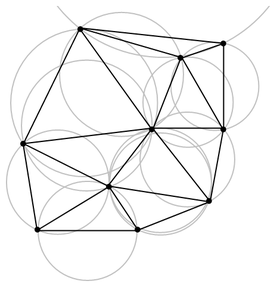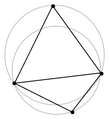Delaunay triangulation
来源:互联网 发布:淘宝客服有底薪吗 编辑:程序博客网 时间:2024/05/20 16:39
http://en.wikipedia.org/wiki/Delaunay_triangulation
Delaunay triangulation
From Wikipedia, the free encyclopedia
Jump to: navigation, search


A Delaunay triangulation in the plane with circumcircles shown
In mathematics, and computational geometry, a Delaunay triangulation for a set P of points in the plane is atriangulation DT(P) such that no point in P is inside the circumcircle of any triangle in DT(P). Delaunay triangulations maximize the minimum angle of all the angles of the triangles in the triangulation(Delaunay triangulation 使整个三角划分中的所有三角形中的最小的角的角度最大化); they tend to avoid skinny triangles. The triangulation was invented by Boris Delaunay in 1934 [1].
Based on Delaunay's definition[1], the circumcircle of a triangle formed by three points from the original point set isempty if it does not contain vertices other than the three that define it (other points are permitted only on the very perimeter, not inside).
The Delaunay condition states that a triangle net is a Delaunay triangulation if all the circumcircles of all the triangles in the net are empty. This is the original definition for two-dimensional spaces. It is possible to use it in three-dimensional spaces by using a circumscribed sphere in place of the circumcircle.
For a set of points on the same line there is no Delaunay triangulation (in fact, the notion of triangulation is undefined for this case).
For 4 points on the same circle (e.g., the vertices of a rectangle) the Delaunay triangulation is not unique: clearly, the two possible triangulations that split the quadrangle into two triangles satisfy the Delaunay condition.
Generalizations are possible to metrics other than Euclidean. However in these cases a Delaunay triangulation is not guaranteed to exist or be unique.
Contents
[hide]
- 1 Relationship with the Voronoi diagram
- 2 n-dimensional Delaunay
- 3 Properties
- 4 Visual Delaunay definition: Flipping
- 5 Algorithms
- 5.1 Flip algorithms
- 5.2 Incremental
- 5.3 Divide and conquer
- 5.4 Sweepline
- 6 Applications
- 7 See also
- 8 References
- 9 External links
edit] Relationship with the Voronoi diagram
The Delaunay triangulation of a discrete point set P corresponds to the dual graph of the Voronoi tessellation for P.
edit] n-dimensional Delaunay
For a set P of points in the (d-dimensional) Euclidean space, a Delaunay triangulation is a triangulation DT(P) such that no point in P is inside the circum-hypersphere of any simplex in DT(P).
It is known that there exists a unique Delaunay triangulation for P, if P is a set of points in general position; that is, no three points are on the same line and no four are on the same circle, for a two dimensional set of points, or no n + 1 points are on the same hyperplane and no n + 2 points are on the same hypersphere, for an n-dimensional set of points. An elegant proof of this fact is outlined below. It is worth mentioning, because it reveals connections between the two constructs fundamental for computational and combinatorial geometry.
The problem of finding the Delaunay triangulation of a set of points in n-dimensional Euclidean space can be converted to the problem of finding the convex hull of a set of points in (n + 1)-dimensional space, by giving each point pan extra coordinate equal to | p | 2, taking the bottom side of the convex hull, and mapping back to n-dimensional space by deleting the last coordinate. As the convex hull is unique, so is the triangulation, assuming all facets of the convex hull aresimplices. A facet not being a simplex implies that n + 2 of the original points lay on the same d-hypersphere, and the points were not in general position.
edit] Properties
Let n be the number of points and d the number of dimensions.
- The union of all simplices in the triangulation is the convex hull of the points.
- The Delaunay triangulation contains at most
 simplices.
simplices. - In the plane (d = 2), if there are b vertices on the convex hull, then any triangulation of the points has at most 2b ? 2 ? b triangles, plus one exterior face (see Euler characteristic).
- In the plane, each vertex has on average six surrounding triangles.
- In the plane, the Delaunay triangulation maximizes the minimum angle. Compared to any other triangulation of the points, the smallest angle in the Delaunay triangulation is at least as large as the smallest angle in any other. However, the Delaunay triangulation does not necessarily minimize the maximum angle.
- A circle circumscribing any Delaunay triangle does not contain any other input points in its interior.
- If a circle passing through two of the input points doesn't contain any other of them in its interior, then the segment connecting the two points is an edge of a Delaunay triangulation of the given points.
- The Delaunay triangulation of a set of points in d-dimensional spaces is the projection of the convex hull of the projections of the points onto a (d+1)-dimensional paraboloid.
edit] Visual Delaunay definition: Flipping
From the above properties an important feature arises: Looking at two triangles ABD and BCD with the common edge BD (see figures), if the sum of the angles α and γ is less than or equal to 180°, the triangles meet the Delaunay condition.
This is an important property because it allows the use of a flipping technique. If two triangles do not meet the Delaunay condition, switching the common edge BD for the common edge AC produces two triangles that do meet the Delaunay condition :

This triangulation does not meet the Delaunay condition (the sum of α and γ is bigger than 180°).

This triangulation does not meet the Delaunay condition (the circumferences contain more than 3 points).

Flipping the common edge produces a Delaunay triangulation for the four points.
edit] Algorithms
All algorithms for computing Delaunay triangulations rely on fast operations for detecting when a point is within a triangle's circumcircle and an efficient data structure for storing triangles and edges. In two dimensions, one way to detect if point D lies in the circumcircle of A, B, C is to evaluate the determinant:

Assuming A, B and C to lie counter-clockwise, this is positive if and only if D lies in the circumcircle.
edit] Flip algorithms
As mentioned above, if a triangle is non-Delaunay, we can flip one of its edges. This leads to a straightforward algorithm: construct any triangulation of the points, and then flip edges until no triangle is non-Delaunay. Unfortunately, this can take O(n2) edge flips, and does not extend to three dimensions or higher[2].
edit] Incremental
The most straightforward way of efficiently computing the Delaunay triangulation is to repeatedly add one vertex at a time, retriangulating the affected parts of the graph. When a vertex v is added, we split in three the triangle that contains v, then we apply the flip algorithm. Done naively, this will take O(n) time: we search through all the triangles to find the one that contains v, then we potentially flip away every triangle. Then the overall runtime is O(n2).
If we insert vertices in random order, it turns out (by a somewhat intricate proof) that each insertion will flip, on average, only O(log n) triangles -- although sometimes it will flip many more. This still leaves the point location time to improve. We can store the history of the splits and flips performed: each triangle stores a pointer to the two or three triangles that replaced it. To find the triangle that contains v, we start at a root triangle, and follow the pointer that points to a triangle that contains v, until we find a triangle that has not yet been replaced. On average, this will also take O(log n) time. Over all vertices, then, this takes O(n log n) time[2]. While the technique extends to higher dimension (as proved by Edelsbrunner and Shah[3]), the runtime can be exponential in the dimension even if the final Delaunay triangulation is small.
edit] Divide and conquer
A divide and conquer algorithm for triangulations in two dimensions is due to Lee and Schachter which was improved by Guibas and Stolfi[4] and later by Dwyer. In this algorithm, one recursively draws a line to split the vertices into two sets. The Delaunay triangulation is computed for each set, and then the two sets are merged along the splitting line. Using some clever tricks, the merge operation can be done in time O(n), so the total running time is O(n log n).[5]
For certain types of point sets, such as a uniform random distribution, by intelligently picking the splitting lines the expected time can be reduced to O(n log log n) while still maintaining worst-case performance.
A divide and conquer paradigm to performing a triangulation in d-dimensions is presented in "DeWall: A fast divide and conquer Delaunay triangulation algorithm in Ed" by P. Cignoni, C. Montani, R. Scopigno.[6]
edit] Sweepline
Fortune's Algorithm uses a sweepline technique to achieve O(n log n) runtime. In some experimental evaluations, the sweepline is the fastest in practice. Unfortunately, it works only in two dimensions.
edit] Applications
The Euclidean minimum spanning tree of a set of points is a subset of the Delaunay triangulation of the same points, and this can be exploited to compute it efficiently.
For modeling terrain or other objects given a set of sample points, the Delaunay triangulation gives a nice set of triangles to use as polygons in the model. In particular, the Delaunay triangulation avoids narrow triangles (as they have large circumcircles compared to their area).


The Delaunay triangulation of a random set of 100 points in a plane.
Delaunay triangulations are often used to build meshes for the finite element method, because of the angle guarantee and because fast triangulation algorithms have been developed. Typically, the domain to be meshed is specified as a coarse simplicial complex; for the mesh to be numerically stable, it must be refined, for instance by using Ruppert's algorithm. This has been implemented by Jonathan Shewchuk in the freely available Triangle package.
edit] See also
- Voronoi diagram
- Gabriel graph
- Pitteway triangulation
edit] References
- ^ a b B. Delaunay: Sur la sphère vide, Izvestia Akademii Nauk SSSR, Otdelenie Matematicheskikh i Estestvennykh Nauk, 7:793-800, 1934
- ^ a b de Berg, Mark; Otfried Cheong, Marc van Kreveld, Mark Overmars (2008). Computational Geometry: Algorithms and Applications. Springer-Verlag. ISBN 978-3-540-77973-5.
- ^ Edelsbrunner, Herbert; Nimish Shah (1996). "Incremental Topological Flipping Works for Regular Triangulations".Algorithmica 15: 223-241, http://www.springerlink.com/content/4gdja72vx1qmg44x/?p=a74909a339d9498cbff326f08b084b4c&pi=1.
- ^ Computing Constrained Delaunay Triangulations
- ^ G. Leach: Improving Worst-Case Optimal Delaunay Triangulation Algorithms. June 1992
- ^ Cignoni, P.; C. Montani; R. Scopigno (1998). "DeWall: A fast divide and conquer Delaunay triangulation algorithm in Ed". Computer-Aided Design 30 (5): 333–341. doi:10.1016/S0010-4485(97)00082-1.
edit] External links
- Real time interactive Voronoi and Delaunay diagrams with source code
- 2D, 3D, and higher dimensional Delaunay triangulation in CGAL, the Computational Geometry Algorithms Library
- Applet for calculation and visualization of convex hull, Delaunay triangulations and Voronoi diagrams in space
- 2D C Delaunay code and Java applet
- C++ 2D Delaunay code
- Mathworld on Delaunay triangulation
- Qhull for computing Delaunay triangulations in 2-d, 3-d, etc.
- Triangle, a 2D Quality Mesh Generator and Delaunay Triangulator (or newer Triangle)
- G. Leach: Improving Worst-Case Optimal Delaunay Triangulation Algorithms. (June 1992)
Retrieved from "http://en.wikipedia.org/wiki/Delaunay_triangulation"
Categories: Discrete geometry | Geometric algorithms | Triangles | Geometric graphs
Views
- Article
- Discussion
- Edit this page
- History
Personal tools
- Log in / create account
Navigation
- Main page
- Contents
- Featured content
- Current events
- Random article
Search
Interaction
- About Wikipedia
- Community portal
- Recent changes
- Contact Wikipedia
- Donate to Wikipedia
- Help
Toolbox
- What links here
- Related changes
- Upload file
- Special pages
- Printable version
- Permanent link
- Cite this page
Languages
- ???????
- Deutsch
- Español
- Français
- ?????
- 日本語
- Polski
- Sloven??ina
- Укра?нська
- Delaunay triangulation
- Delaunay Triangulation
- Delaunay Triangulation算法学习
- Delaunay Triangulation算法学习
- Dlib中Delaunay Triangulation
- Delaunay三角剖分(Delaunay Triangulation)
- Delaunay三角剖分(Delaunay Triangulation)概述
- 关于Delaunay triangulation那些事
- Delaunay Triangulation, Divide And Conquer Method
- 笔记:Delaunay三角剖分(Delaunay Triangulation)相关知识
- Delaunay三角剖分(Delaunay Triangulation)相关知识(转)
- Delaunay三角剖分(Delaunay Triangulation)相关知识
- 笔记:Delaunay三角剖分(Delaunay Triangulation)相关知识
- Delaunay三角剖分(Delaunay Triangulation)相关知识
- 笔记:Delaunay三角剖分(Delaunay Triangulation)相关知识
- 笔记:Delaunay三角剖分(Delaunay Triangulation)相关知识
- 笔记:Delaunay三角剖分(Delaunay Triangulation)相关知识
- Delaunay三角剖分(Delaunay Triangulation)相关知识
- ubuntu shared folder to windows
- perl基础-7 (Perl编程24学时教程)
- Struts2中jsp前台传值到action后台的三种方式以及valueStack的使用
- fedora16设置root登录
- 浮华沧桑的伤感完美日志发布:有伤痕,才算完美
- Delaunay triangulation
- [Linux][2012-11-01] openssl demo 例子
- iOS 5编程入门经典(第3版)
- OD断方法
- od使用技巧
- js让图片自动按比例缩小代码
- Activity的架构设计
- unity使用的50个技巧
- Java常用方法大全


